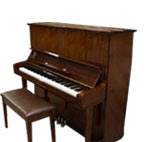Off the Keys — Piano Practice Tips for Adults
Listening – This one is obvious but easily overlooked. Find a professional recording of each piano song you are learning and make a playlist you can listen to in the car, around the house, or at work. You will reinforce tricky rhythms, changing tempos, dynamics, pedaling, and so on each time you hear it played accurately.
Hand Shape – You should already know the importance of playing with a rounded hand shape, free from tension. If you have a squishy ball on your desk at work, pick it up right now and look at your hand shape. You should be able to see all three knuckles. Each knuckle has an important part to play in good hand shape, but the knuckle closest to your fingernail is the most important. As a rule, that knuckle should never wiggle or collapse. Here are some ways to reinforce hand shape while away from the keys:
- After observing your hand shape while holding the ball, put the ball down but keep the same hand shape. You should be able to touch the desktop with all four fingertips and the side tip of your thumb. Be sure your wrist is lifted.
- With that good hand shape, leave your fingers touching the desk and use a little pressure to push into the desk. Release without lifting away from the desk and push in again without letting any of the knuckles wiggle or collapse. Do this without allowing tension to build up in your hands by allowing the pressure to transfer to the fingertips.
- Now try tapping fingers individually without letting the knuckles wiggle or collapse.
- For a greater challenge, widen your span so that the thumb and pinky are fully extended, as if playing an octave. Slide the three long fingers toward your palm until only the flat ends of the fingers are touching the desk. Tap those three long fingers on the desk without letting the knuckle wiggle or collapse, together and individually.
Eliminate Tension – If you typically feel like your muscles are all knotted up after you finish a practice session, you are probably allowing tension to build up without even knowing it. Being aware of how tension feels and where you feel it, as well as when you feel it the most, are the first steps toward eliminating it. Wherever you are right now, take a moment to evaluate the tension in your own body.
- Spine – Start here and think about your posture. Are you hunched over or leaning to one side? With your feet resting flat on the floor, center yourself by straightening your spine from the bottom up. If you are near a wall, stand and let the back of your head rest on the wall. This will establish the feeling of good posture. Go back to your seat and sit quietly for 10 seconds with this corrected posture. With consistent reminders, your posture will improve!
- Shoulders – Breathe in deeply and exhale. Did your shoulders drop? Do they feel more relaxed now?
- Elbows – Are they suspended away from your body, causing your arms to ache and fingers to stiffen? Drop those elbows and let them rest at your side.
- Wrists – You should be able to lift your wrists up and down with a beautiful fluid motion. Rest your forearms on the arms of your office chair and let your hands hang from the wrists. Slowly raise your forearms, bending at the elbows and keeping your hands relaxed, letting them dangle from the wrists. You can practice this while on the phone, reading emails, or during lunch!
When you do return to the keys, incorporate these important piano practice tips into your routine. Eventually your body will form natural, healthy habits that will greatly enhance your musicianship!
Here’s a visual to recap these tips…











